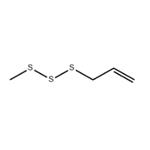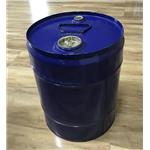Allyl methyl trisulfide (AMS) (50-200 mg/kg, orally, daily, 30 days) has protective effect in STZ-induced hyperglycemia rats. It can lead to a significant decrease in the expression of blood glucose and pro-inflammatory markers TNF-α, IL-6, and NF-κB p65, while increasing plasma insulin levels, and has some antioxidant activity[1].
| Animal Model: | Male Wistar rats (170-190 g)[1] |
| Dosage: | 50, 100 and 200 mg/kg |
| Administration: | orally in the daily morning for 30 days |
| Result: | Enhanced body, organ weight and reduced food, water intake.
Dose-dependently decreased plasma glucose and enhanced insulin.
Attenuated the oxidative stress stimulated by STZ in hepatocytes.
Increased activity of hepatotoxicity markers AST, ALT and ALP.
Significantly downregulated the expression of pro-inflammatory proteins, cytokines (TNF-α and IL-6) and transcription factors (NF-κB p65). |



